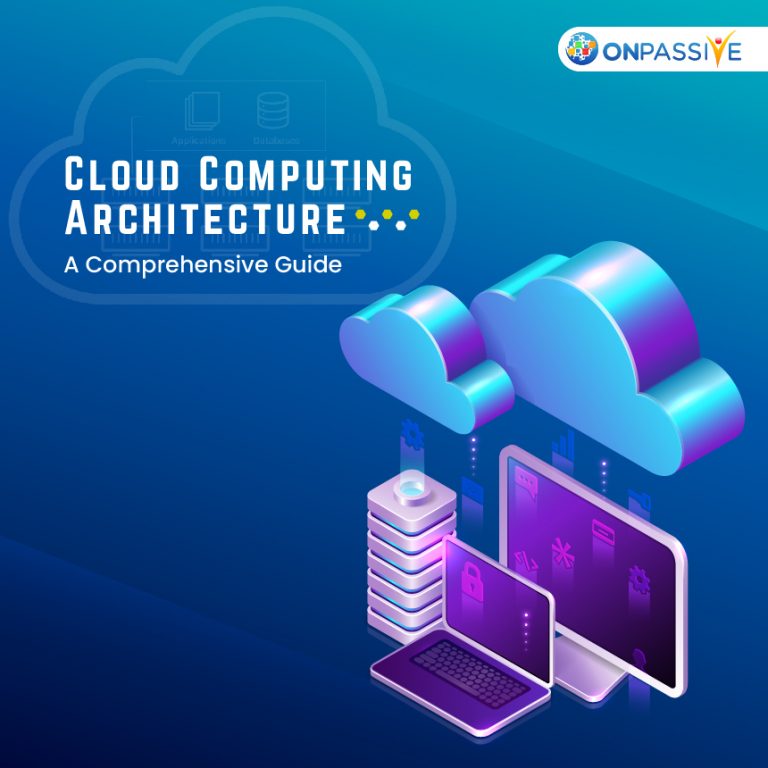
Cloud computing is the delivery of computing services through the Internet – including servers, databases, storage, networking and software. For any business that uses large databases and servers, buying and maintaining physical data centers and servers is an expensive and tedious task. Cloud services help such businesses to reduce the operation cost and run the infrastructure more efficiently.
The term cloud computing architecture is used to refer components and sub-components embedded in cloud computing. Enterprises prefer cloud computing architecture due to its high bandwidth and efficiency in data storage.
Cloud computing architecture consists of two components i.e.
a. Front-end or Client-side
b. Back-end
These two components communicate or connect via a network or through the Internet.
a. Front-end/Client-side
The front-end is the user-facing or client-facing part of cloud computing architecture. It comprises of Client’s side interfaces and applications that help the users to access cloud computing services. Web browsers (Google Chrome, Internet Explorer), local networks, mobile or other devices like PC or Laptop, and standard web apps are examples of front-end architecture. Gmail is an example of a cloud service with its front-end in the form of a web application. Gmail interface allows the end-users to access its services as a whole.
b. Back-end
Back-end architecture empowers the front-end architecture, and it is managed by the cloud computing service providers or the hosts. The back-end is a considerable component of Cloud computing architecture that comprises many servers, data storage systems, traffic control mechanisms and security systems.
Components of Cloud Computing Architecture
Client Infrastructure
It is the only component of front-end architecture that consists of hardware and software components like software, user interface, servers and devices that allow users to access the cloud computing architecture. It also provides a Graphical User Interface (GUI) to interact with the cloud.
Application
It is an essential component of back-end architecture that offers a user interface to its end-users to send queries. It is a software or a platform that takes care of the Client’s requirements with the back-end resources.
Services
It is a substantial component of the back-end that provides utility to the entire back-end cloud architecture. Services handle most of the operations that are executed on the cloud computing system. Web Services, Storage and application development environment are some of the cloud services. The deployment of these cloud services is executed using deployment software. Deployment software comprises all necessary installations and configurations that are essential to run the cloud services. Cloud computing services include:
a. Infrastructure-as-a-Service (IaaS)
It is an on-demand service, where instead of buying software or a server you can rent all these IT infrastructures from a cloud provider. IaaS method delivers everything from the operating system to the storage through IP based connectivity with pay-as-you-go pricing. The most famous examples of the IaaS system are Microsoft Azure and IBM cloud.
b. Software-as-a-Service (SaaS)
In SaaS-based service, a software application is delivered to the customer over the Internet, on-demand. It follows a subscription basis model and allows user to connect to the application with a web browser on their phone or PC.
c. Platform-as-a-Services (PaaS)
PaaS supplies an on-demand platform that focuses on developing, testing, deployment, and managing your application.
Storage
Cloud storage is the space where every bit of data that belongs to the cloud application is stored. It allows users to store data by transferring it over the Internet. Users can access this stored data from anywhere and modify and retrieve it at any time. Microsoft Azure, IBM Cloud, Oracle Cloud-Storage are some of the most popular cloud storage service providers.
Management
Management software plays a significant role in managing different back-end architecture components like application, service, storage, security, and coordination among them. It is responsible for allocating specific resources to a specific task. Management software acts as a middleware where it divides system resources between the front-end and the back-end in a seamless manner. It is very significant for the smooth functioning of a cloud environment.
Security
Security is an integral and crucial aspect of any cloud computing infrastructure. Security is an in-built component of back-end architecture that implements a security mechanism, allowing easier debugging if it faces any issue. Loss of data is a significant concern for any enterprise. Virtual firewalls enable cloud security to prevent data loss and redundancy mechanisms.
Benefits of Cloud Computing Architecture
- It reduces Capex costs as there is no need to purchase and maintain high-cost equipment.
- It provides advanced high-security features that keep the stored data safe from attackers.
- It enables enterprises, small or big, to efficiently scale up or scale down their IT resources.
- It allows easy access to data via any devices and encourages remote working.
- It provides quick data recovery, preventing the loss of data.
Conclusion
Undoubtedly, cloud computing architecture is revolutionizing a large part of the IT industry. It not only allows enterprises to store data but also helps in flexible workload optimization. It provides advanced high security to the system, which protects and prevents any loss of data. With the massive advancements in cloud technology, cloud computing is expected to witness significant growth shortly.


